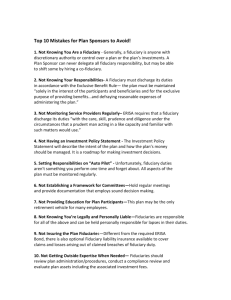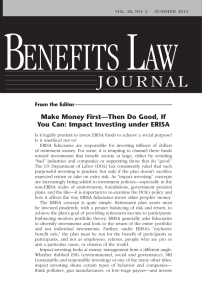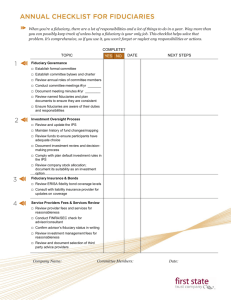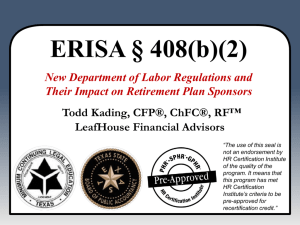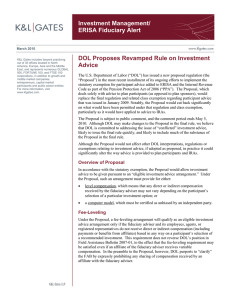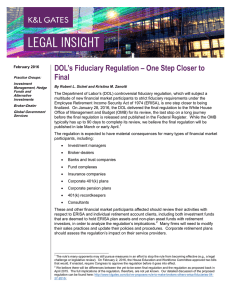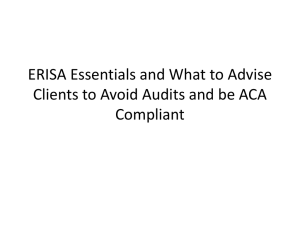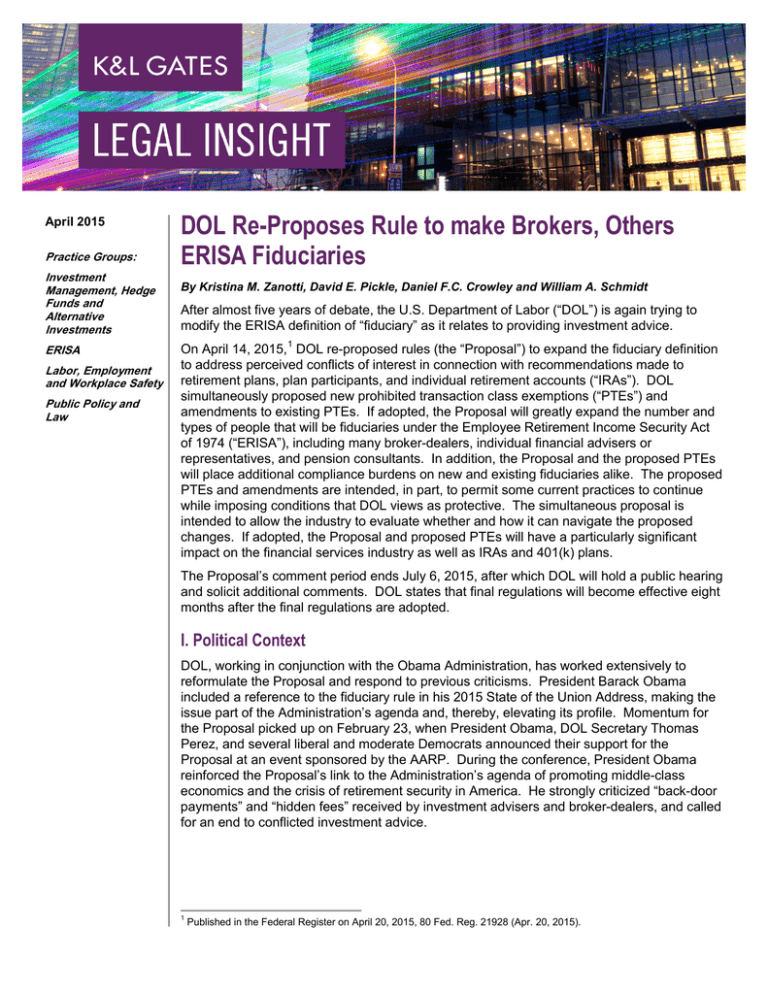
April 2015
Practice Groups:
Investment
Management, Hedge
Funds and
Alternative
Investments
ERISA
Labor, Employment
and Workplace Safety
Public Policy and
Law
DOL Re-Proposes Rule to make Brokers, Others
ERISA Fiduciaries
By Kristina M. Zanotti, David E. Pickle, Daniel F.C. Crowley and William A. Schmidt
After almost five years of debate, the U.S. Department of Labor (“DOL”) is again trying to
modify the ERISA definition of “fiduciary” as it relates to providing investment advice.
On April 14, 2015, 1 DOL re-proposed rules (the “Proposal”) to expand the fiduciary definition
to address perceived conflicts of interest in connection with recommendations made to
retirement plans, plan participants, and individual retirement accounts (“IRAs”). DOL
simultaneously proposed new prohibited transaction class exemptions (“PTEs”) and
amendments to existing PTEs. If adopted, the Proposal will greatly expand the number and
types of people that will be fiduciaries under the Employee Retirement Income Security Act
of 1974 (“ERISA”), including many broker-dealers, individual financial advisers or
representatives, and pension consultants. In addition, the Proposal and the proposed PTEs
will place additional compliance burdens on new and existing fiduciaries alike. The proposed
PTEs and amendments are intended, in part, to permit some current practices to continue
while imposing conditions that DOL views as protective. The simultaneous proposal is
intended to allow the industry to evaluate whether and how it can navigate the proposed
changes. If adopted, the Proposal and proposed PTEs will have a particularly significant
impact on the financial services industry as well as IRAs and 401(k) plans.
The Proposal’s comment period ends July 6, 2015, after which DOL will hold a public hearing
and solicit additional comments. DOL states that final regulations will become effective eight
months after the final regulations are adopted.
I. Political Context
DOL, working in conjunction with the Obama Administration, has worked extensively to
reformulate the Proposal and respond to previous criticisms. President Barack Obama
included a reference to the fiduciary rule in his 2015 State of the Union Address, making the
issue part of the Administration’s agenda and, thereby, elevating its profile. Momentum for
the Proposal picked up on February 23, when President Obama, DOL Secretary Thomas
Perez, and several liberal and moderate Democrats announced their support for the
Proposal at an event sponsored by the AARP. During the conference, President Obama
reinforced the Proposal’s link to the Administration’s agenda of promoting middle-class
economics and the crisis of retirement security in America. He strongly criticized “back-door
payments” and “hidden fees” received by investment advisers and broker-dealers, and called
for an end to conflicted investment advice.
1
Published in the Federal Register on April 20, 2015, 80 Fed. Reg. 21928 (Apr. 20, 2015).
DOL Re-Proposes Rule to make Brokers, Others ERISA
Fiduciaries
II. Expansion of Fiduciary Definition, Elimination of Five-Part Test
Under ERISA Section 3(21) a person acting in a non-discretionary capacity is an ERISA
fiduciary “to the extent” he or she renders investment advice to a plan for a fee (or has any
responsibility to do so). 2 This is important not only for purposes of the fiduciary duty and
prohibited transaction provisions that apply to retirement plans under Title I of ERISA, but
also for purposes of the prohibited transaction provisions that apply to retirement plans,
IRAs, and other tax-favored savings accounts (such as Coverdell Education Savings
Accounts and Health Savings Accounts) under the Internal Revenue Code (“Code”). 3 The
current and longstanding regulation 4 limits this aspect of the fiduciary definition to a person
that satisfies each part of a five-part test: the person provides advice (1) for a fee, (2) on a
regular basis, (3) pursuant to an express or implied mutual agreement, arrangement, or
understanding that (4) such advice will serve as the primary basis for investment decisions,
and (5) the advice will be based on the particular needs of the plan.
The Proposal would replace the 5-part test with a new definition under which a person would
render fiduciary investment advice if: (1) for a fee or other compensation, direct or indirect,
(2) he or she provides investment or investment management recommendations (including
recommendations regarding distributions or rollovers) or appraisals to an employee benefit
plan, a plan fiduciary, participant or beneficiary, or an IRA owner, and (3) either (a)
acknowledges the fiduciary nature of the advice, or (b) acts pursuant to an agreement,
arrangement, or understanding with the advice recipient that the advice is individualized to,
or specifically directed to, the recipient for consideration in making investment or
management decisions regarding plan or IRA assets.
If the Proposal is adopted, people who provide recommendations or suggestions about
retirement-related investments would be much more likely to be ERISA fiduciaries because
the Proposal removes or alters a number of the elements in the existing definition. For
example: (i) advice would no longer need to be provided on a “regular” basis; a single
recommendation would be enough to confer fiduciary status; (ii) the advice would no longer
need to be the “primary” basis for the advice recipient’s decision; just the fact that it is
considered would be enough; and (iii) there would be no need for a “mutual” agreement that
the advice be based on the “particular needs” of the plan; just an understanding that the
advice is individualized for or specifically directed to the recipient. 5
The Proposal states that if the advice provider acknowledges its fiduciary status with respect
to the advice, that person is automatically a fiduciary. As a contractual acknowledgement of
fiduciary status is built into the new “Best Interest Contract Exemption” (discussed further
below), which many service providers will presumably need to comply with in order to avoid
prohibited transactions, anyone attempting to comply with the Best Interest Contract
Exemption would lose the ability to argue that it was not an ERISA fiduciary.
The Proposal specifically provides that the following types of communications constitute
fiduciary investment advice:
2
A person is also a fiduciary to the extent he or she exercises any discretionary authority or control with respect to the
management of a plan or its assets or has any discretionary authority or responsibility in the administration of a plan.
3
This Alert focuses on the effect of the new proposed regulations on ERISA employee benefit plans and IRAs. Generally,
the new regulations impact Coverdell Education Savings Accounts, Health Savings Accounts and other covered taxfavored savings accounts in the same way as IRAs.
4
29 C.F.R. § 2510.3-21(c).
5
This provision would still allow recommendations made to the general public, such as through newsletters.
2
DOL Re-Proposes Rule to make Brokers, Others ERISA
Fiduciaries
•
recommendations regarding the acquisition, holding, disposing or exchanging of
securities or other property, notably including recommendations to take a
distribution or recommendations as to the investment of securities or other
property to be rolled over or otherwise distributed from an ERISA plan or IRA; 6
•
recommendations as to the management of securities or other property, including
individualized advice or recommendations as to proxy voting;
•
appraisals or valuations of investments in connection with specific transactions
(excluding valuations done solely to comply with reporting and disclosure
provisions required by law, regulation, or self-regulatory organization, appraisals
to collective investment funds or pooled separate accounts, and appraisals of
employer securities to ESOPs); and
•
recommendations on the selection of other fiduciary investment advisers or
investment managers.
A “recommendation” under the Proposal is defined broadly to mean any “communication
that, based on its content, context, and presentation, would reasonably be viewed as a
suggestion that the advice recipient engage in or refrain from taking a particular course of
action.” DOL is soliciting comments to determine whether it should adopt FINRA standards to
assist in evaluating whether a particular communication could be viewed as a
recommendation.
III. Carve-outs and Exclusions
There are a number of potentially useful carve-outs built into the Proposal. If a carve-out
applies, then the person who would otherwise be considered a fiduciary by reason of
providing investment advice would not be a fiduciary. 7
A. The “Seller’s Carve-Out”
The “Seller’s Carve-Out” covers certain statements or recommendations made to a
sophisticated ERISA plan fiduciary of a large plan (at least 100 participants) by a
counterparty acting in an arm’s-length transaction. Although deemed the “seller’s” carve out,
it would cover any incidental advice made in connection with an arm’s-length sale, purchase,
loan, or bilateral contract. Prior to making any recommendation with respect to the
transaction, the counterparty must make disclosures and satisfy certain conditions designed
to confirm that the independent plan fiduciary is sufficiently sophisticated and aware of the
impartial nature of the recommendation.
The Seller’s Carve-Out does NOT cover advice made to small plans, IRA owners, or plan
participants and beneficiaries (e.g., in defined contribution plans under which participants
direct their investments). For IRA owners, plan participants and beneficiaries, and plan
6
This would reverse DOL’s previous position on advice regarding distributions and rollovers. See DOL Advisory Opinion
2005-23A (Dec. 7, 2005) in which DOL held that recommendations to a plan participant to take an otherwise permissible
distribution, even combined with a recommendation as to how to invest distributed funds, is not fiduciary investment
advice.
7
Service providers that can take advantage of a carve-out need not worry about fiduciary self-dealing and conflicts of
interest or complying with a PTE. In addition, because an advice provider that fits within a carve-out would not be a
fiduciary at all under ERISA, there would be significant barriers to any plaintiff that sought to bring suit under ERISA for
breach of fiduciary duty.
3
DOL Re-Proposes Rule to make Brokers, Others ERISA
Fiduciaries
sponsors of small, non participant-directed plans, the Best Interest Contract Exemption
(discussed below) would be available for those arrangements, provided its conditions are
met.8
B. Swap Recommendations
The Proposal would generally not cover offers or recommendations to independent plan
fiduciaries of ERISA plans by swap dealers or major swap participants to enter into a swap
that is regulated under the Securities Exchange Act or the Commodity Exchange Act,
provided the swap counterparty obtains a written representation that the plan fiduciary will
not rely on the swap counterparty’s recommendations.
C. Employees
The Proposal would not cover statements or recommendations provided to a plan fiduciary
of an ERISA plan by an employee of the plan sponsor acting in its capacity as employee, if
the employee receives only his or her normal compensation.
D. Platform Providers
The Proposal would not cover the marketing of a non-individualized, pre-packaged, platform,
or similar mechanism, to a participant-directed ERISA plan, through which a plan fiduciary
may select or monitor investment alternatives, provided the platform provider discloses to the
plan fiduciary that the provider is not undertaking to provide impartial investment advice or
advice in a fiduciary capacity. A platform provider can also assist the plan fiduciary with
identifying investment alternatives that meet objective criteria specified by the plan fiduciary
and providing objective financial data and comparisons with independent benchmarks
without being considered to provide fiduciary investment advice.
This carve-out would not be available with respect to IRAs and other tax-favored retirement
vehicles that are not ERISA plans.
E. Certain Valuations and Appraisals
As mentioned above, the Proposal would carve out valuations done solely to comply with
reporting and disclosure provisions required by law, regulation, or self-regulatory
organization, appraisals to collective investment funds or pooled separate accounts, and
appraisals regarding employer securities given to ESOPs. DOL notes that it remains
concerned about ESOP appraisals and indicated that it may address that issue in a separate
regulation.
F. Education
The Proposal generally adopts DOL’s long-standing view that investment “education” is not
fiduciary investment advice. The types of activities constituting education under the
Proposal, such as basic information about the plan; general financial, investment, and
retirement information; and asset allocation models, generally match up with those listed in
Interpretive Bulletin 96-1 (which would be superseded). Importantly, however, the use of
8
Notably, however, neither the Seller’s Carve-Out nor the Best Interest Contract Exemption would be available for advice
to plan sponsors of small, participant-directed plans.
4
DOL Re-Proposes Rule to make Brokers, Others ERISA
Fiduciaries
asset allocation models that identify specific investment alternatives would no longer be
treated as non-fiduciary investment education.
G. Order-Taking
The Proposal makes clear that a broker will not be deemed a fiduciary solely because the
broker executes transactions in securities following specific directions of an independent plan
fiduciary or IRA owner where no advice is provided.
IV. Best Interest Contract Exemption
Many, if not most, of the persons who would be treated as fiduciaries under the Proposal
receive compensation that could be viewed as violating the prohibited transaction restrictions
of ERISA and the Code relating to prohibited self-dealing and conflicts of interest. In order to
address these issues DOL took several actions to modify and propose new PTEs.
The most significant of the proposed PTEs is the “Best Interest Contract Exemption.”
Although a person providing investment advice (as defined in the Proposal) to an IRA owner
or 401(k) plan participant would still be a fiduciary, the Best Interest Contract Exemption
would allow the receipt of compensation by that person if its conditions are met. The Best
Interest Contract Exemption applies only in connection with investment advice given to plan
participants and beneficiaries, IRA owners, and plan sponsors of small (fewer than 100
participants) non participant-directed ERISA plans.
The Best Interest Contract Exemption has the potential to impose some significant
compliance burdens. New contracts would need to be entered into that contain all of the
required provisions, including an acknowledgement of fiduciary status and an obligation to
adhere to certain “impartial conduct standards,” which essentially impose by contract the
ERISA prudence and loyalty requirements of ERISA Section 404(a). 9 Fiduciaries would also
need to set-up or modify policies and procedures for managing conflicts of interest. Certain
compensation structures for individual advisers would not be allowed if they would tend to
encourage recommendations that are not in the best interest of the investor. The fiduciary
would need to make additional disclosures of fees and conflicts of interests and maintain a
public webpage showing direct and indirect compensation paid to individual advisers, the
financial institution, and any affiliate in connection with any asset or class of assets that the
investor is able to purchase, hold, or sell, or has purchased, held, or sold within the last 365
days, the source of compensation, and how the compensation varies within and among
assets classes. Any fiduciary wanting to rely on the Best Interest Contract Exemption would
have to notify DOL of its intent to rely on the exemption prior to receiving any compensation
in reliance on the exemption and the fiduciary would be subject to additional recordkeeping
requirements.
The exemption would only cover recommendations with respect to limited categories of
investments. Although the categories listed include most “common” investments by plans
and IRAs, certain types of assets would not be covered, such as real estate, security futures,
puts, calls, straddles, and options, as well as non-publicly traded equity securities.
Businesses seeking to make recommendations regarding these alternative investments may
not be able to do so without violating ERISA.
9
As discussed below, this requirement seems primarily intended to give IRA owners a contractual right of action for
breach of fiduciary duty where there is no statutory right of action under the Code.
5
DOL Re-Proposes Rule to make Brokers, Others ERISA
Fiduciaries
The proposed exemption also requires that a financial institution offer for purchase, sale, or
holding, and the individual financial adviser to make available to the investor, a broad range
of investment options.10 If recommendations are made with respect to a limited investment
menu that does not provide a broad range of investment options (such as one that only
includes proprietary funds) that would be permitted only if: (1) the financial institution makes
a specific written finding that the menu limitations do not prevent the investment adviser from
providing advice that is in the best interest of the investor; (2) the payments received in
connection with the limited menu are reasonable in relation to the value of the specific
services provided in exchange for the payments and not in excess of the services’ fair
market value; (3) before giving any recommendations, the financial institution or investment
adviser gives clear written notice to the investor of any limitations placed by the financial
institution on the investment products offered by the investment provider; and (4) the
individual financial adviser notifies the investor if the adviser does not recommend a
sufficiently broad range of assets to meet the investor’s needs.
V. Insurance and Annuity Contract Exemption
As part of the Best Interest Contract Exemption, DOL is proposing an exemption for
transactions in insurance and annuity contracts subject to certain conditions. This portion of
the exemption would be available with respect to recommendations made to IRA owners,
participants and beneficiaries of participant-directed ERISA plans, and non participantdirected ERISA plans with fewer than 100 participants. The exemption generally requires
that the annuities be purchased for cash as part of the insurer’s ordinary course of business,
and on terms at least as favorable as those that apply to non-retirement investors.
As discussed below, the existing exemption for insurance and annuity contracts transactions,
PTE 84-24, would no longer be available for non-discretionary investment advice fiduciaries
to IRAs in connection with transactions involving variable annuity contracts or other annuity
contracts that would constitute “securities” under federal securities laws. Such fiduciaries
would have to rely on this part of the Best Interest Contract Exemption.
VI. Other New PTEs and Amendments to Existing PTEs
Along with the Best Interest Contract Exemption, DOL is proposing other PTEs and
amendments to existing PTEs. Although the primary focus of the Proposal is on nondiscretionary investment advice providers, discretionary investment managers currently
relying on an existing PTE subject to amendment should evaluate how the proposed
changes would impact them.
A. Principal Transactions
DOL is proposing a new exemption that would allow non-discretionary investment advice
fiduciaries to engage in purchases and sales of certain debt securities to plans, participant or
beneficiary accounts, and IRAs out of their own inventory. Among other contractual
requirements, a contractual acknowledgement of fiduciary status and the same “impartial
conduct standards” from the Best Interest Contract Exemption would apply in addition to
disclosure and recordkeeping requirements.
10
Unless the menu of investment options is selected by an independent plan fiduciary.
6
DOL Re-Proposes Rule to make Brokers, Others ERISA
Fiduciaries
B. PTE 86-128 & PTE 75-1, Part II(2)
Non-discretionary investment advice fiduciaries to IRAs would no longer be able to use PTE
86-128, the exemption used for executing securities transactions with affiliated brokers.
Going forward, they would likely need to rely on the Best Interest Contract Exemption.
Investment advice fiduciaries to ERISA plans and discretionary fiduciaries would continue to
be able to use PTE 86-128, but would be subject to the same impartial conduct standards
set out in the Best Interest Contract Exemption. In addition, DOL proposes to limit the
compensation permitted under PTE 86-128 to “commissions” rather than the broader forms
of compensation described in PTE 86-128 in its current form.
DOL has also proposed to revoke PTE 75-1, Part II(2), which covers principal sales of
mutual funds by brokers and the receipt of commissions for the same. PTE 86-128 would
instead cover that type of transaction, but the definition of permissible commissions would
specifically exclude 12b-1 fees, revenue-sharing payments, marketing fees, administrative
fees, sub-TA fees, or sub-accounting fees.
C. PTE 75-1, Part I(b) and (c)
DOL would revoke PTE 75-1, Part I(b) and (c), which currently provide relief for certain nonfiduciary services to plans and IRAs, including clearance, settlement, custodial, and analyst
services. Instead, such service providers would need to rely on the services exemption in
ERISA section 408(b)(2) and Code section 4975(d)(2). This is the standard services
exemption that applies to other types of service providers to ERISA plans and IRAs.
D. PTE 75-1, Part V
DOL would amend PTE 75-1, Part V to permit investment advice fiduciaries to receive
compensation for lending money or otherwise extending credit for the limited purpose of
avoiding a failed securities transaction. Currently, the exemption permits brokers to extend
credit to a plan or IRA “in connection with” the purchase or sale of securities. 11
E. PTE 84-24
PTE 84-24 currently permits certain non-discretionary investment advice fiduciaries to
receive commissions in connection with the purchase of certain mutual fund shares and
insurance or annuity contracts. DOL would amend 84-24 so that it could not be used for
investment advice fiduciaries to IRA owners in connection with transactions involving (1)
variable annuity contracts or other annuity contracts that would constitute “securities” under
federal securities laws or (2) mutual fund shares. Those fiduciaries would have to rely on the
Best Interest Contract Exemption. In addition, DOL would amend 84-24 to include the same
impartial conduct standards found in the Best Interest Contract Exemption.
F. Import of Impartial Conduct Standards to Existing PTEs
DOL would amend several PTEs to include the impartial conduct standards found in the Best
Interest Contract Exemption:
•
11
PTE 75-1, Part III (relating to certain acquisitions of securities by plans from
related parties in underwriting transactions);
Unamended, PTE 75-1, Part V is only available to brokers that are fiduciaries on a no compensation basis.
7
DOL Re-Proposes Rule to make Brokers, Others ERISA
Fiduciaries
•
75-1, Part IV (relating to certain acquisitions of securities by plans from fiduciary
market makers);
•
77-4 (relating to transactions by plans with respect to open-end mutual funds
advised by plan fiduciaries);
•
80-83 (relating to purchases of securities by plans the proceeds of which are
used by the issuer to retire or reduce debt); and
•
83-1 (relating to certain mortgage pool investment trust transactions).
G. Low-Fee Exemption
DOL announced that it is considering an additional PTE for products that are high-quality but
feature low-fees, and requested comments on possible terms for such an exemption.
VII. Particular Focus on IRAs
The Proposal has a particular focus on advice provided with respect to IRAs. DOL
expressed a special concern about the risks of conflicted advice to IRA owners, given an IRA
owner’s lack of an independent plan fiduciary to represent his or her interest, and the
absence of a private right of action for IRA owners under the Code. The Proposal attempts
to address these perceived risks by adding and amending exemptions to build in an ERISA
prudence standard that does not currently apply to IRAs under the Code, and to give IRA
owners a private contractual right of action for fiduciary breaches under the Best Interest
Contract Exemption. As discussed above, DOL would also reverse its previous position on
advice regarding rollovers, making recommendations to take a distribution or making
investment recommendations with respect to a rollover explicitly fiduciary investment advice
under the Proposal.
VIII. Potential Congressional Response and Next Steps
DOL and the Administration are clearly committed to finalizing the Proposal and proposed
PTEs. At this time, the position of key constituencies is unclear. In 2010, the combined
bipartisan opposition of Republicans, coupled with Members of the Congressional Black
Caucus (“CBC”) and the Congressional Hispanic Caucus (“CHC”), ultimately led to the
withdrawal of the original rule. CBC and CHC members, in particular, raised concerns about
the disparate impact of the rule on the minority community. However, the Proposal’s
principles-based approach and expanded PTEs, including the possibility of an exemption for
high-quality, low-fee products, could reduce the CBC and CHC’s opposition to the rule.
Most Members of Congress and their staffs have generally adopted a cautious approach on
the Proposal, as they are still digesting the rule, given its relative complexity and the unclear
effect it may have on the provision of retirement advice and services.
Oversight hearings, conferences, and litigation are all possible in the near future. We expect
that Members of Congress and stakeholders opposed to the rule will emphasize arguments
relating to cost-benefit analysis and a lack of coordination between the SEC and the DOL as
the prime reasons to delay the Proposal. In contrast, supporters of the rule will most likely
focus their efforts on building support with policymakers who were wary of the 2010 iteration
but who might be more sympathetic to the current version of the Proposal, particularly
groups such as the CBC and CHC. Given the rule’s principles-based approach and Best
8
DOL Re-Proposes Rule to make Brokers, Others ERISA
Fiduciaries
Interest Contract Exemption, we expect that more policymakers will be in favor of the
Proposal (particularly Democrats).
In sum, although there are both strong supporters and opponents of the Proposal, many
policymakers and stakeholders are less certain, and are carefully analyzing the Proposal and
its new structure, as well as analyzing its arguments supporting and opposing the Proposal,
before they determine a position, issue public statements, and take next steps. However,
given President Obama’s public support for the Proposal, the relatively quick review of the
Proposal by the Office of Management and Budget (“OMB”) (completed in half the usual
time), 12 and DOL’s strong motivation to get this in place, the Proposal may move quickly
towards finalization.
The Proposal raises the very real possibility of profound change. If finalized, many new
fiduciaries will need to evaluate their ERISA responsibilities and their ability to comply with
the various exemptions. Business and compensation models that do not fit within the PTEs
would not be able to continue to operate without violating ERISA and the Code.
Consequently, we recommend that interested parties identify the key issues that potentially
affect their business and move quickly to develop and pursue a strategy to seek to influence
the policy debate in order to resolve them.
Authors:
Kristina M. Zanotti
David E. Pickle
Daniel F.C. Crowley
William A. Schmidt
kristina.zanotti@klgates.com
+1.202.778.9171
david.pickle@klgates.com
+1.202.778.9887
dan.crowley@klgates.com
+1.202.778.9447
william.schmidt@klgates.com
+1.202.778.9373
Anchorage Austin Beijing Berlin Boston Brisbane Brussels Charleston Charlotte Chicago Dallas Doha Dubai Fort Worth Frankfurt
Harrisburg Hong Kong Houston London Los Angeles Melbourne Miami Milan Moscow Newark New York Orange County Palo Alto Paris
Perth Pittsburgh Portland Raleigh Research Triangle Park San Francisco São Paulo Seattle Seoul Shanghai Singapore Spokane
Sydney Taipei Tokyo Warsaw Washington, D.C. Wilmington
K&L Gates comprises more than 2,000 lawyers globally who practice in fully integrated offices located on five
continents. The firm represents leading multinational corporations, growth and middle-market companies, capital
markets participants and entrepreneurs in every major industry group as well as public sector entities, educational
institutions, philanthropic organizations and individuals. For more information about K&L Gates or its locations,
practices and registrations, visit www.klgates.com.
This publication is for informational purposes and does not contain or convey legal advice. The information herein should not be used or relied upon in
regard to any particular facts or circumstances without first consulting a lawyer.
© 2015 K&L Gates LLP. All Rights Reserved.
12
Megan Leonhardt, “DOL Fiduciary Rule Released Publicly,” (Apr. 13, 2015), http://wealthmanagement.com/industry/dolfiduciary-rule-released-publicly (discussing OMB’s expedited review).
9

